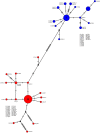Molecular Epidemiology and Assemblage Typing of Giardia duodenalis in School-Age Children Situated along the Southern Shoreline of Lake Malawi, Malawi
- PMID: 37549892
- PMCID: PMC10484258
- DOI: 10.4269/ajtmh.23-0156
Molecular Epidemiology and Assemblage Typing of Giardia duodenalis in School-Age Children Situated along the Southern Shoreline of Lake Malawi, Malawi
Abstract
Almost all human giardiasis infections are caused by Giardia duodenalis assemblages A and B. Differentiation between human infections with these assemblages, as well as between single-assemblage (A or B) and mixed-assemblage (A and B) infections, is therefore needed to better understand the pathological impact of infection with either, or both, assemblages. We assessed the prevalence of G. duodenalis assemblages A and B using 305 fecal samples provided by school-age children situated along the southern shoreline of Lake Malawi. Concurrently, intestinal pathology data were also collected to test for association(s) between assemblage infection status and intestinal health. Prevalence of G. duodenalis infection was 39.3% by real-time polymerase chain reaction. Of all identified infections, 32% were single G. duodenalis assemblage A and 32% were single G. duodenalis assemblage B, whereas 33% were mixed-assemblage infections. Fifteen unique G. duodenalis assemblage A and 13 unique G. duodenalis assemblage B β-giardin haplotypes were identified. There was a positive association between single infection with G. duodenalis assemblage B and both self-reporting of abdominal pain (odds ratio [OR]: 3.05, P = 0.004) and self-reporting of diarrhea (OR: 3.1, P = 0.003). No association between single infection with assemblage A and any form of intestinal pathology was found. Additionally, there was a positive association between mixed-assemblage infections and self-reporting of abdominal pain (OR: 3.1, P = 0.002). Our study highlights the importance G. duodenalis assemblage typing and reaffirms the need for improved access to water, sanitation and hygiene infrastructure in rural areas of low- and middle-income countries.
Figures





Similar articles
-
Diagnostic Accuracy of Various Genetic Markers (tpi, gdh, and bg) for Prevalence and Genotyping of Giardia duodenalis in Human Samples: A Comparative Global Systematic Review and Meta-Analysis.Acta Parasitol. 2025 Jul 14;70(4):161. doi: 10.1007/s11686-025-01101-3. Acta Parasitol. 2025. PMID: 40660056
-
Clinical Manifestations and Molecular Identification of Giardia duodenalis in Pediatric and Adolescent Cancer Patients in Southwestern Iran.Foodborne Pathog Dis. 2025 Jul;22(7):498-504. doi: 10.1089/fpd.2024.0100. Epub 2024 Oct 15. Foodborne Pathog Dis. 2025. PMID: 39403771
-
Giardia duodenalis in Rodents: A Global Systematic Review and Meta-Analysis.Vet Med Sci. 2025 Sep;11(5):e70546. doi: 10.1002/vms3.70546. Vet Med Sci. 2025. PMID: 40792600 Free PMC article. Review.
-
Molecular prevalence of Giardia duodenalis in domestic pig (Sus domesticus) and captive wild boar (Sus scrofa) in China: A systematic review and meta-analysis.Vet Parasitol Reg Stud Reports. 2025 Jan;57:101151. doi: 10.1016/j.vprsr.2024.101151. Epub 2024 Nov 6. Vet Parasitol Reg Stud Reports. 2025. PMID: 39855845
-
Global prevalence of Giardia duodenalis in cattle: A systematic review and meta-analysis.Prev Vet Med. 2022 Jun;203:105632. doi: 10.1016/j.prevetmed.2022.105632. Epub 2022 Mar 28. Prev Vet Med. 2022. PMID: 35427916
Cited by
-
Human Giardiasis in Ghana - A Scoping Review of Studies From 2004 to 2024.Health Sci Rep. 2025 May 5;8(5):e70822. doi: 10.1002/hsr2.70822. eCollection 2025 May. Health Sci Rep. 2025. PMID: 40330749 Free PMC article.
-
Population genetics and molecular xenomonitoring of Biomphalaria freshwater snails along the southern shoreline of Lake Malawi, Malawi.Parasit Vectors. 2024 Dec 18;17(1):521. doi: 10.1186/s13071-024-06546-5. Parasit Vectors. 2024. PMID: 39696654 Free PMC article.
-
Molecular epidemiology and population genetics of Schistosoma mansoni infecting school-aged children situated along the southern shoreline of Lake Malawi, Malawi.PLoS Negl Trop Dis. 2024 Oct 7;18(10):e0012504. doi: 10.1371/journal.pntd.0012504. eCollection 2024 Oct. PLoS Negl Trop Dis. 2024. PMID: 39374309 Free PMC article.
References
Publication types
MeSH terms
Substances
LinkOut - more resources
Full Text Sources
Medical

